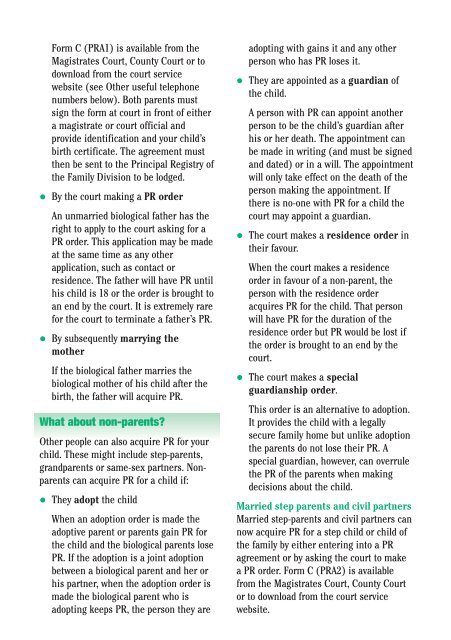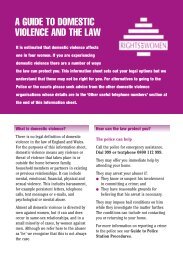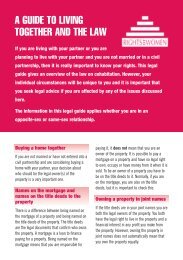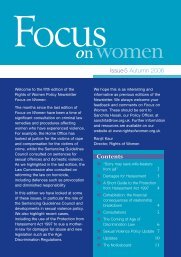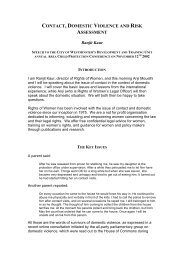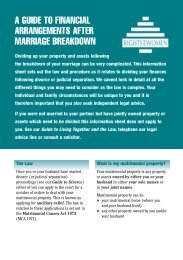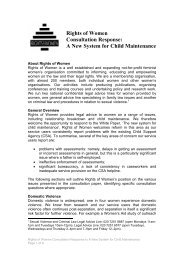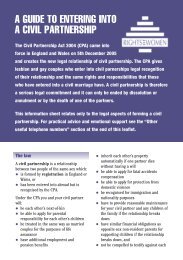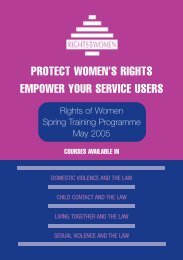Parental Responsibility - Rights of Women
Parental Responsibility - Rights of Women
Parental Responsibility - Rights of Women
You also want an ePaper? Increase the reach of your titles
YUMPU automatically turns print PDFs into web optimized ePapers that Google loves.
Form C (PRA1) is available from the<br />
Magistrates Court, County Court or to<br />
download from the court service<br />
website (see Other useful telephone<br />
numbers below). Both parents must<br />
sign the form at court in front <strong>of</strong> either<br />
a magistrate or court <strong>of</strong>ficial and<br />
provide identification and your child’s<br />
birth certificate. The agreement must<br />
then be sent to the Principal Registry <strong>of</strong><br />
the Family Division to be lodged.<br />
By the court making a PR order<br />
An unmarried biological father has the<br />
right to apply to the court asking for a<br />
PR order. This application may be made<br />
at the same time as any other<br />
application, such as contact or<br />
residence. The father will have PR until<br />
his child is 18 or the order is brought to<br />
an end by the court. It is extremely rare<br />
for the court to terminate a father’s PR.<br />
By subsequently marrying the<br />
mother<br />
If the biological father marries the<br />
biological mother <strong>of</strong> his child after the<br />
birth, the father will acquire PR.<br />
What about non-parents?<br />
Other people can also acquire PR for your<br />
child. These might include step-parents,<br />
grandparents or same-sex partners. Nonparents<br />
can acquire PR for a child if:<br />
They adopt the child<br />
When an adoption order is made the<br />
adoptive parent or parents gain PR for<br />
the child and the biological parents lose<br />
PR. If the adoption is a joint adoption<br />
between a biological parent and her or<br />
his partner, when the adoption order is<br />
made the biological parent who is<br />
adopting keeps PR, the person they are<br />
adopting with gains it and any other<br />
person who has PR loses it.<br />
They are appointed as a guardian <strong>of</strong><br />
the child.<br />
A person with PR can appoint another<br />
person to be the child’s guardian after<br />
his or her death. The appointment can<br />
be made in writing (and must be signed<br />
and dated) or in a will. The appointment<br />
will only take effect on the death <strong>of</strong> the<br />
person making the appointment. If<br />
there is no-one with PR for a child the<br />
court may appoint a guardian.<br />
The court makes a residence order in<br />
their favour.<br />
When the court makes a residence<br />
order in favour <strong>of</strong> a non-parent, the<br />
person with the residence order<br />
acquires PR for the child. That person<br />
will have PR for the duration <strong>of</strong> the<br />
residence order but PR would be lost if<br />
the order is brought to an end by the<br />
court.<br />
The court makes a special<br />
guardianship order.<br />
This order is an alternative to adoption.<br />
It provides the child with a legally<br />
secure family home but unlike adoption<br />
the parents do not lose their PR. A<br />
special guardian, however, can overrule<br />
the PR <strong>of</strong> the parents when making<br />
decisions about the child.<br />
Married step parents and civil partners<br />
Married step-parents and civil partners can<br />
now acquire PR for a step child or child <strong>of</strong><br />
the family by either entering into a PR<br />
agreement or by asking the court to make<br />
a PR order. Form C (PRA2) is available<br />
from the Magistrates Court, County Court<br />
or to download from the court service<br />
website.


